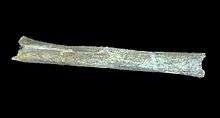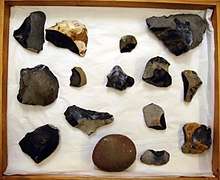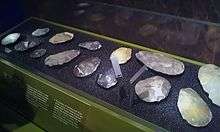Eartham Pit, Boxgrove
Eartham Pit is an internationally important Lower Palaeolithic archaeological site north-east of Boxgrove in West Sussex. The oldest human remains in Britain have been discovered on the site, fossils of Homo heidelbergensis dating to 500,000 years ago.[2] It is a 9.8-hectare (24-acre) geological Site of Special Scientific Interest[1][3] and a Geological Conservation Review site.[4]
| Site of Special Scientific Interest | |
| Area of Search | West Sussex |
|---|---|
| Grid reference | SU 923 086[1] |
| Interest | Geological |
| Area | 9.8 hectares (24 acres)[1] |
| Notification | 1997[1] |
| Location map | Magic Map |
The other key Palaeolithic sites in the UK are Swanscombe, Pontnewydd, Kents Cavern, Paviland, and Gough's Cave. Boxgrove is also one of the oldest sites with direct evidence of hunting/butchering by humans.
The site is close to a fossil shoreline which has interglacial mammal fauna in intertidal sediments.[5] Parts of the site complex were excavated between 1982 and 1996 by a team led by Mark Roberts of the Institute of Archaeology, University College London. The site is situated in an area that features a buried chalk cliff that overlooked a flat beach (which contained a waterhole) stretching around half a mile (1 km) south to the sea.
History
The site is important for many reasons, including the degree of preservation of ancient land surfaces, the impressive total extent of the palaeo-landscape beyond the quarries (over 26 km wide), its huge quantity of well-preserved animal bones, its numerous flint artifacts, and its hominin bones which are among some of the most ancient found yet in Europe. Several of the animal bones are the oldest found specimens of their species, such as the wing bone of the great auk found at the site in 1989. The combination of bones, stone artifacts, and the geology of the landscape gives a very complete picture of the coastal plain as it existed half a million years ago.[6]



Numerous Acheulean flint tools and remains of animals dating to around 500,000 years ago were found at the site.[7] Some of the bones were found to display cut marks, and some of the tools bear use wear traces indicative of cutting meat, indicating that the site was used for butchery by some of the earliest occupants of the British Isles. They shared the area with a wide variety of animals whose bones have been found there, including lion, bear, rhino and giant deer, as well as numerous smaller animals such as frog, vole and birds.[2] Comparison with ethnographic and experimental examples of stone-tool-assisted butchery has shown that game animals at Boxgrove were expertly butchered, and it is likely that the variety of animal life in the area attracted human hunters.
Evidence for hunting is, however, tentative, consisting primarily of a horse shoulder blade with a semicircular hole that has been interpreted as a projectile impact mark. Given that wooden spears decay very quickly, it is no surprise that no hunting equipment has been found on the site. As well, it is a fact that wooden spears do not generally cause great damage to the bony areas of impact such as the pelvis. Thus, the horse shoulder blade markings are a rare piece of evidence of hunting activity.
Remains of Homo heidelbergensis were first found on the site in 1993, comprising the partial tibia of a male who probably stood 1.8m high and weighed around 80 kg.[8][9] Significantly, this is the only postcranial element of Homo Heidelbergensis to have been found in Northern Europe (in other words, coming from anywhere other than the skull). The tibia is extremely robust for its size and may be an indication of high running activity, presumably in tracking an animal after it has been speared. Both ends of the bone show signs of gnawing, possibly by a wolf, suggesting that perhaps the Boxgrove hominids were sometimes prey to other animals. In 1995 two incisor teeth from another individual were found. These show evidence of severe periodontal disease and show tool cut marks, which are thought to have been caused by use of flint tools near the mouth rather than indicate cannibalism.
In 2003 English Heritage announced it would buy the western quarry (known as Quarry 1) to ensure the preservation of the site complex. [10]
Excavation
Mark Roberts (2011)[11]
Roberts became the site director of the Boxgrove project.
In 2011, Roberts told interviewers from the student-produced archaeological magazine Artifact that Boxgrove was "a fickle mistress indeed" and that whilst he wouldn't change his experience in investigating the site, the excavations "extracted a very heavy price" from him, "a price that I am only just at the point of paying the final instalment on". For this reason he found that he often hummed The Specials' 1979 song "Too Much Too Young" to himself when thinking about the project.[12]
Publication
In 1998, Roberts co-wrote a book about the site with prehistoric archaeologist Mike Pitts that was entitled Fairweather Eden: Life in Britain half a million years ago as revealed by the excavations at Boxgrove. Published by Arrow Books, Fairweather Eden was designed for a popular audience.


The English Heritage monograph: Boxgrove: A Middle Pleistocene hominid site at Eartham Quarry, Boxgrove, West Sussex is now available through the Archaeology Data Service.[13]
See also
References
- Footnotes
- "Designated Sites View: Eartham Pit, Boxgrove". Sites of Special Scientific Interest. Natural England. Retrieved 23 April 2019.
- "500000 BC - Boxgrove". Current Archaeology. 24 May 2007. Retrieved 23 April 2019.
- "Map of Eartham Pit, Boxgrove". Sites of Special Scientific Interest. Natural England. Retrieved 23 April 2019.
- "Eartham Pit, Boxgrove (Quaternary of South Central England)". Geological Conservation Review. Joint Nature Conservation Committee. Retrieved 6 April 2019.
- "Eartham Pit, Boxgrove citation" (PDF). Sites of Special Scientific Interest. Natural England. Retrieved 23 April 2019.
- Pitts, M. & Roberts, M. "Fairweather Eden". Fromm International: New York, 1997. ISBN 0-88064-247-5
- Stout, Dietrich; Apel, Jan; Commander, Julia; Roberts, Mark (2014-01-01). "Late Acheulean technology and cognition at Boxgrove, UK". Journal of Archaeological Science. 41: 576–590. doi:10.1016/j.jas.2013.10.001. ISSN 0305-4403.
- "BBC - Science & Nature - The evolution of man". www.bbc.co.uk. Retrieved 2018-01-30.
- "ARCHAEOLOGY: Boxgrove Man reveals his Stone Age-old secrets". The Independent. 1994-06-22. Retrieved 2018-01-30.
- "Research and Conservation framework for the British palaeolithic". English Heritage: 9. Archived from the original (PDF) on 24 April 2019. Retrieved 1 November 2010. Cite journal requires
|journal=(help) - Kontonicolas, Ali and Roberts 2011. p. 13.
- Kontonicolas, Ali and Roberts 2011. pp. 12-13.
- Parfitt, S., Roberts, M. (1999) "Boxgrove: A Middle Pleistocene hominid site at Eartham Quarry, Boxgrove, West Sussex" English Heritage
- Bibliography
- Pitts, Michael and Roberts, Mark (1998). Fairweather Eden: Life in Britain half a million years ago as revealed by the excavations at Boxgrove. London: Arrow. ISBN 978-0-09-964491-0.CS1 maint: multiple names: authors list (link)
- Kontonicolas, MaryAnn; Ali, Irrum (2011). "Disco in Boxgrove". Artifact Magazine. 01: 12–13.
| Wikimedia Commons has media related to Eartham Pit. |